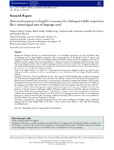How much exposure to English is necessary for a bilingual toddler to perform like a monolingual peer in language tests?
| dc.contributor.author | Cattani, Allegra | |
| dc.contributor.author | Abbot-Smith, K | |
| dc.contributor.author | Farag, R | |
| dc.contributor.author | Krott, A | |
| dc.contributor.author | Arreckx, F | |
| dc.contributor.author | Dennis, I | |
| dc.contributor.author | Floccia, Caroline | |
| dc.contributor.editor | Bloch B | |
| dc.contributor.editor | Botting N | |
| dc.date.accessioned | 2015-06-22T12:21:30Z | |
| dc.date.accessioned | 2017-09-18T13:05:23Z | |
| dc.date.available | 2015-06-22T12:21:30Z | |
| dc.date.available | 2017-09-18T13:05:23Z | |
| dc.date.issued | 2014 | |
| dc.identifier.issn | 1368-2822 | |
| dc.identifier.issn | 1460-6984 | |
| dc.identifier.uri | http://hdl.handle.net/10026.1/9949 | |
| dc.description.abstract |
Background: Bilingual children are under-referred due to an ostensible expectation that they lag behind their monolingual peers in their English acquisition. The recommendations of the Royal College of Speech and Language Therapists (RCSLT) state that bilingual children should be assessed in both the languages known by the children. However, despite these recommendations, a majority of speech and language professionals report that they assess bilingual children only in English as bilingual children come from a wide array of language backgrounds and standardized language measures are not available for the majority of these. Moreover, even when such measures do exist, they are not tailored for bilingual children. Aims: It was asked whether a cut-off exists in the proportion of exposure to English at which one should expect a bilingual toddler to perform as well as a monolingual on a test standardized for monolingual English-speaking children. Methods & Procedures: Thirty-five bilingual 2;6-year-olds exposed to British English plus an additional language and 36 British monolingual toddlers were assessed on the auditory component of the Preschool Language Scale, British Picture Vocabulary Scale and an object-naming measure. All parents completed the Oxford Communicative Development Inventory (Oxford CDI) and an exposure questionnaire that assessed the proportion of English in the language input. Where the CDI existed in the bilingual’s additional language, these data were also collected. Outcomes & Results: Hierarchical regression analyses found the proportion of exposure to English to be the main predictor of the performance of bilingual toddlers. Bilingual toddlers who received 60% exposure to English or more performed like their monolingual peers on all measures. K-means cluster analyses and Levene variance tests confirmed the estimated English exposure cut-off at 60% for all language measures. Finally, for one additional language for which we had multiple participants, additional language CDI production scores were significantly inversely related to the amount of exposure to English. Conclusions & Implications: Typically developing 2;6-year-olds who are bilingual in English and an additional language and who hear English 60% of the time or more, perform equivalently to their typically developing monolingual peers. | |
| dc.format.extent | 649-671 | |
| dc.format.medium | Print-Electronic | |
| dc.language | English | |
| dc.language.iso | English | |
| dc.publisher | Wiley | |
| dc.relation.replaces | http://hdl.handle.net/10026.1/3380 | |
| dc.relation.replaces | 10026.1/3380 | |
| dc.subject | bilingualism | |
| dc.subject | lexicon | |
| dc.subject | language delay | |
| dc.subject | assessment | |
| dc.title | How much exposure to English is necessary for a bilingual toddler to perform like a monolingual peer in language tests? | |
| dc.type | journal-article | |
| dc.type | Article | |
| plymouth.author-url | https://www.webofscience.com/api/gateway?GWVersion=2&SrcApp=PARTNER_APP&SrcAuth=LinksAMR&KeyUT=WOS:000344372000002&DestLinkType=FullRecord&DestApp=ALL_WOS&UsrCustomerID=11bb513d99f797142bcfeffcc58ea008 | |
| plymouth.edition | 2014 | |
| plymouth.issue | 6 | |
| plymouth.volume | 49 | |
| plymouth.publication-status | Published | |
| plymouth.journal | International Journal of Language and Communication Disorders | |
| dc.identifier.doi | 10.1111/1460-6984.12082 | |
| plymouth.organisational-group | /Plymouth | |
| plymouth.organisational-group | /Plymouth/Faculty of Health | |
| plymouth.organisational-group | /Plymouth/Faculty of Health/School of Psychology | |
| plymouth.organisational-group | /Plymouth/REF 2021 Researchers by UoA | |
| plymouth.organisational-group | /Plymouth/REF 2021 Researchers by UoA/UoA04 Psychology, Psychiatry and Neuroscience | |
| plymouth.organisational-group | /Plymouth/REF 2021 Researchers by UoA/UoA04 Psychology, Psychiatry and Neuroscience/UoA04 REF peer reviewers | |
| plymouth.organisational-group | /Plymouth/Research Groups | |
| plymouth.organisational-group | /Plymouth/Research Groups/Centre for Brain, Cognition and Behaviour (CBCB) | |
| plymouth.organisational-group | /Plymouth/Research Groups/Centre for Brain, Cognition and Behaviour (CBCB)/Cognition | |
| plymouth.organisational-group | /Plymouth/Research Groups/Plymouth Institute of Health and Care Research (PIHR) | |
| plymouth.organisational-group | /Plymouth/Users by role | |
| plymouth.organisational-group | /Plymouth/Users by role/Academics | |
| dc.publisher.place | UK | |
| dcterms.dateAccepted | 2013-12-30 | |
| dc.identifier.eissn | 1460-6984 | |
| dc.rights.embargoperiod | Not known | |
| rioxxterms.versionofrecord | 10.1111/1460-6984.12082 | |
| rioxxterms.licenseref.uri | http://www.rioxx.net/licenses/all-rights-reserved | |
| rioxxterms.licenseref.startdate | 2014 | |
| rioxxterms.type | Journal Article/Review | |
| plymouth.funder | Lexicon development in bilingual toddler::ESRC |


